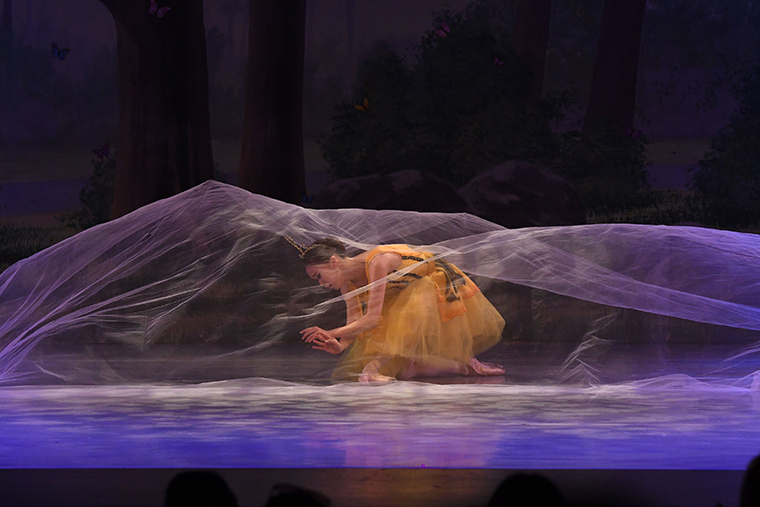
Janis Liu as the Princess Farfalla in "Le Papillon" (Photo credit by Patricia Laine Romero)
Dance in Miami is booming with the potential of seeing two or three different performances in any given weekend. Here are three up and coming performances ranging from the most traditional to the most unexpected.
In classical ballet, Arts Ballet Theatre of Florida, under the direction of Vladimir Issaev, presents the full evening ballet “Le Papillon” or “The Butterfly” in Aventura on Saturday, March 2 and Sunday, March 3 and in Fort Lauderdale on Saturday, March 9 and Sunday, March 10. With the joyous music of Jacques Offenbach, the two act ballet is a showcase for the talented Arts Ballet Theatre (ABT) dancers and a magical "fairy tale" evening of dance for audiences.
"Papillon" was originally premiered by the Paris Opera Ballet in 1860 with choreography by the early sylph-like ballerina, Marie Taglioni, credited as being the first ballerina to dance en pointe. She was a beautiful romantic era artist who was known for having integrity and elegance in her movements rather than being a trickster in her technique; working mostly on balances and the use of her arms and head. She was creating the new ballet for her protégée, Emma Livry.
Today, "Papillon,” led by the fairy, Hamza, the princess, Farfalla, and the prince, Djalma, has been restaged and choreographed by Issaev who last presented "Papillon" in 2016.
While much of the steps are set, Issaev points out that he specifically adapts his choreography to show the skill and technique of the ABT dancers in their performances.
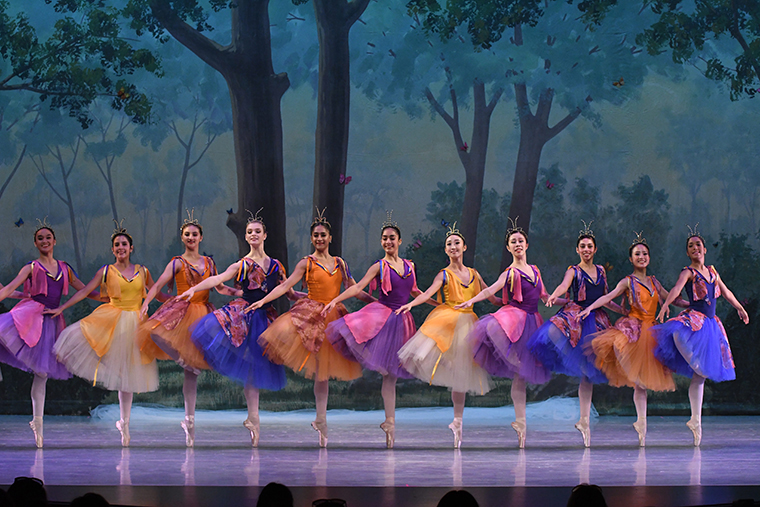
Corps de Ballet of "Le Papillon," ("The Butterfly") (Photo by Patricia Laine Romero)
“ 'Papillon' is my favorite ballet,” says Issaev. “A while ago, I was in St. Petersburg (Russia) and I saw only the pas de deux from ‘Papillon.’ I was curious to see the whole ballet. Later, I flew to South Africa to teach, and I saw a big poster for 'Le Papillon.' I thought ‘Oh, it’s come back to me again.” Then I brought the music here. I had it for about ten years.”
When ABT needed to do a new ballet, “Le Papillon” came to mind and after much research, Issaev began to bring the ballet to life.
As a man who has friends and dance colleagues throughout the world, Issaev does much traveling to teach for companies and schools. During the preparation for "Papillon," he happened to be traveling to Malaysia.
“In Malaysia, I visited a wonderful butterfly park. In a big space with a net, there were millions of butterflies of different colors. It gave me images for movement and color,” says Issaev.
He designed and oversaw the costumes and building of the set and says they are very happy and colorful.
The story of ‘Papillon’ is one of love, drama and humor. In a twist, the mischievous fairy, Hamza, is a role played by a man who dances sur les pointes (on pointe) executing tour en l’air (turns in the air) complete with wig and dress. The princess, Farfalla is kidnapped and, as fairy tale princes always are, Djarma is valiant and noble.
Issaev says the ballet is romantic with drama and humor, and "very beautiful to look at."
“The audience will be happy,” he says.
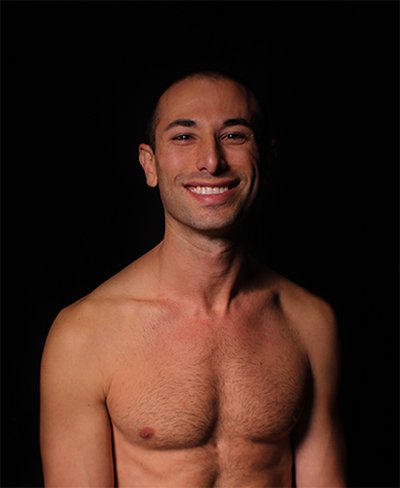
Pioneer Winter of Pioneer Winter Collective
In a more contemporary vein, Pioneer Winter Collective presents “Ten Years from Now: Duets Reimagined.” The evening is a series of duets created over the course of a decade that are being recreated by Winter to be performed on Wednesday, March 6 and Thursday, March 7 at the Sandrell Rivers Theater in Liberty City. Four of the duets were originally danced by Winter himself.
“In every piece I’ve done, I’ve learned something,” says Winter. “I realize I’m always choreographing something new. So this duets program, for me, is looking back. I guess there is just as much looking back as there is looking forward.”
Rather than being one of the performers, as he usually is, Winter is "stretching myself in a different way." He is going to be the speaker and host, if you will, to transition the audience from duet to duet, offering shape to how he wants the audience to start and experience the evening.
“I feel like artists can get stuck sometimes in the thing that they think they are. I’m a choreographer, but I realize that choreography can be applied to many other things. So this is an opportunity for me to be a little more vulnerable, to share my stories.”
The program of seven duets opens with Winter reading. "You are all dancers. Dancers are always looking in the mirror." There will be numerous mirrors that are moved to reflect the audience, the duets and to form a sort of transitionary space as the action ensues.
A revived duet from 2017, “Forced Entry” with Katrina Petrarca and Junior Domingos, has both artists wearing heels. By using Domingos, who is new in the role, the duet has a different dynamic and meaning from the original, says Winter..
“This time, it is very much about androgyny, appreciation and a sort of competitiveness, but not in a brutish way."
Bringing back “Gimp Gait” with chair dancer, Marjorie Burnett, is a piece that Winter used to perform himself. This time Petrarca, a strong performer, is dancing with Burnett.
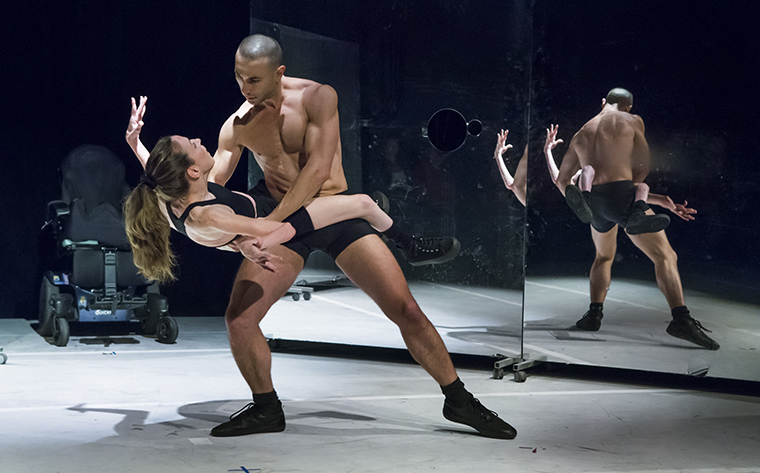
"Gimp Gait" performance with Marjorie Burnett and Pioneer Winter in 2017. For "Duets," it is being reimagined with Burnett and Katrina Petrarca. (Photo credit by Mitchell Zachs)
“I never realized how uncomfortable it is,” says Winter. “Your lumbar and hips are burning to hold Marjorie so carefully. In this new version, you really see Katrina, as Marjorie describes it, as her dark matter, her power that you don’t see.”
“Mother-Son (Days)” from 2012 is one of the pieces that is closest to Winter’s heart. It reflects journal entries and memories from his mother, who passed away when Winter was nine years old.
Niurca Marquez and Aeon De La Cruz will perform the work.
“Aeon is doing my part,” says Winter. “It’s an opportunity for me to see what really works and pull out what doesn’t. Aeon spent hours watching videos - and it really gave me a new perspective to look into the piece once again.”
Another duet is from “Reprise.” Chair dancer, Hector Machado and Marquez, are two of PWC’s most consistent members. Machado is now much more facile and experienced than when he originally performed it.
“I feel like now it’s more about the communication, the rhythm,” says Winter. “It’s two people trying to communicate and, with a mutual understanding that to be heard, you have to be vulnerable enough to be hurt.”
Other performers are Jessica Gilmore and Dani F. Amaro with production design by Shannon Veguilla, sound design by Diego Melgar, Dani F. Amaro, and Juraj Kojs, poetry by Arsimmer McCoy, and lighting design by Apon Nichols.
Reinvestigating these duets has made Winters relook at his extensive body of work.
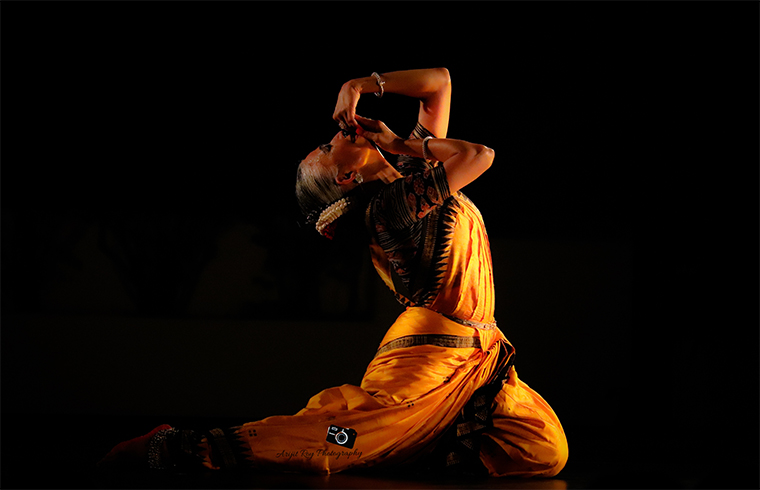
Bijayini Satpathy in the curved movement of Odissi Dance technique (Photo by Arijit Roy)
“I feel like this is new territory, it’s dangerous and I’m taking risks here. It’s all about the dancing, all about the auditory experience. These are duets that touch on a unique sense of expression. I want the audience to see and feel every detail.”
Moving in a very different direction, Live Arts Miami presents Bijayini Satpathy in a solo work entitled “Abhipssa: A Seeking” on Saturday, March 9 at the Miami-Dade College North Campus, Lehman Theater.
Satpathy giggles a bit when asked what inspired her to dance.
“I was very young and I found myself constantly making shapes with my body. Feeling a great sense of joy and finding an inner world very early on. My first memory was of looking into a painting and seeing my reflection in the glass. I was moving and making gestures without knowing anything about Odissi and I found a great sense of awareness of another kind,” she says. “And that feeling just keeps coming.”
Satpathy is a master in a dance style called Odissi. It is the state dance of Orissa (now Odisha), and one of the eight classical dance forms of India. The notation of each dance form is very complex and specific, but suffice to say, each one is influenced by local folk arts, the habits, the food, the literature and language, even the clothing and mannerisms.
Odissi has a special connection to the temple structures, beautiful curved forms, mostly of women, in a celebration of life. It is a celebration of sensuality and the sensuality of the human form, again the female form. This is contained in thousands of structures in the temples of India.
“Most of that information comes into the physical vocabulary seen in Odissi,” she says. “ It is an ’S’ like pattern, a spiraling pattern created within the body and in space. The flavor of Odissi dance is the curved grace, the lyricism that is curved.”
Satpathy explains that other dance forms having to do with language and poetry are linear.
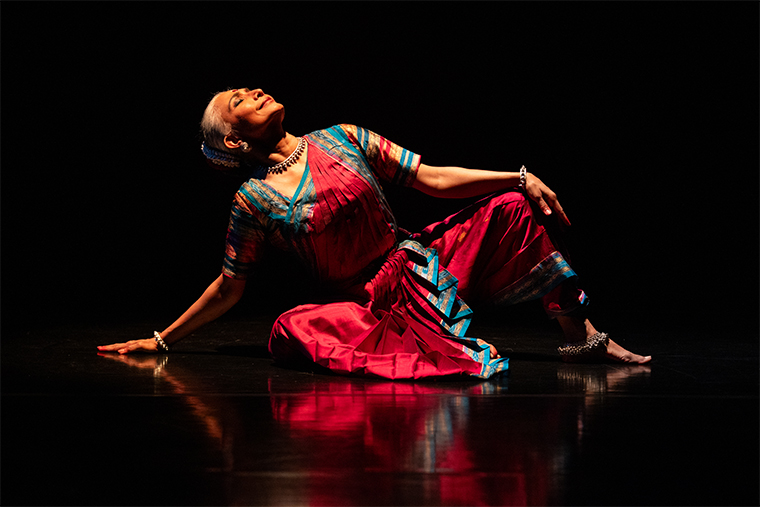
The serene elegance of Bijayini Satpathy in performance. (Photo by Maria Baranova)
“There is no space for curves,” she says. It is difficult to understand, yet as Satpathy explains, it makes absolute sense.
Satpathy danced with the Nrityagram Dance Ensemble for 25 years before breaking off on her own just before the pandemic hit.
“I loved dancing there, but it was just time, the universe was conspiring,” she says. “I wanted to explore Odissi. It was my embodied experience for a long time, actually, that I wanted to put my hands to it. I wanted to give shape to my own voice, to tell my stories, and to bring my opinion onto the stage.”
Satpathy was always with a community of dancers; she lived in a dance village where they lived and farmed and danced all day long together as a group. Embarking alone was very scary. She often asked herself ‘Is this the end or is it a beginning?’
One very unique quality of Odissi, that Satpathy uses during her show, is the transcendence of gender. With her single female costume, she performs characters that are female, male, gods, animals, any gender any character that the story has.
“Basically, we transcend self,” she says.
“My first dance in the traditional repertoire is always an invocation. It immediately gives me access to become more than myself,” she says. “In a way, I’m stretching the borders of Odissi. There are many gods and goddesses iconography to choose from. I’ve chosen one that is both masculine and feminine in one body called Shiva.”
In the dance, there is constant comparison between the power of the masculine and the beauty of the feminine. Satpathy has chosen to view it as a young girl who has come to the temple and sees this image and what goes through her head. She is taking the story to another level and adding another layer.
“There are two things that help us convey the stories. One is the physical and the other is what’s happening on the inside in the moment. The feelings, the emotion. They have to be true in the moment.”
“Abhipssa: A Seeking” is in four sections. The first section is the iconography explored through a young girl when seeing Shiva. The second part is exploring the various nuances of Odissi. The third dance is an emotional dance about separation. The final section celebrates death as the place where the soul is most joyous.
Satpathy says the audience may not understand everything she’s doing. Her job is to connect with the audience and stay in constant communication.
“I want to grab at people’s gut. If we can, without speaking, be connected energetically, that’s a good day for me,” she concludes.
- “Le Papillon” by Arts Ballet Theater. Saturday, March 2, 7:30 p.m. and Sunday, March 3, 3 p.m. at Aventura Arts & Cultural Center, 3385 NE 188th Street, Aventura.
Tickets: www.aventuracenter.org.- Saturday, March 9, 7:30 p.m. and Sunday, March 10, 3 p.m. at Broward Center for the Performing Arts, Amaturo Theater, 201 SW 5th Ave. Ft. Lauderdale
Tickets: www.browardcenter.org.- “Ten Years From Now: Duets, Reimagined” by Pioneer Winter Collective Wednesday and Thursday, March 6 and 7, 7 p.m. at the Sandrell Rivers Theater, 6103 NW 7 Ave, Miami.
Tickets: tickets.ftfshows.com
Box office: (305) 284-8872.- “Abhipssa: A Seeking” by Bijayini Satpathy. Saturday, March 9, 8 p.m. at Lehman Theater, MDC North Campus, 11380 NW 27th Ave. Miami
Tickets: www.liveartsmiami.org.- Master Classes with Bijayini Satpathy Wednesday, March 6 at 7 p.m., Rhythms School of Dance, 595 Corporate Plaza, 10388 West State Road 84, Suite 112, Davie. "The Language of Expressional Dance or Abhinaya" encompasses learning of 9 basic emotions, the language of hand gestures and their application. Participants will learn to translate their own ideas, imagination and stories in expressional and gestural language. Thursday, March 7 at 7 p.m.Sanctuary of the Arts 410 Andalusia Ave Coral Gables. Masterclass tickets and registration.




